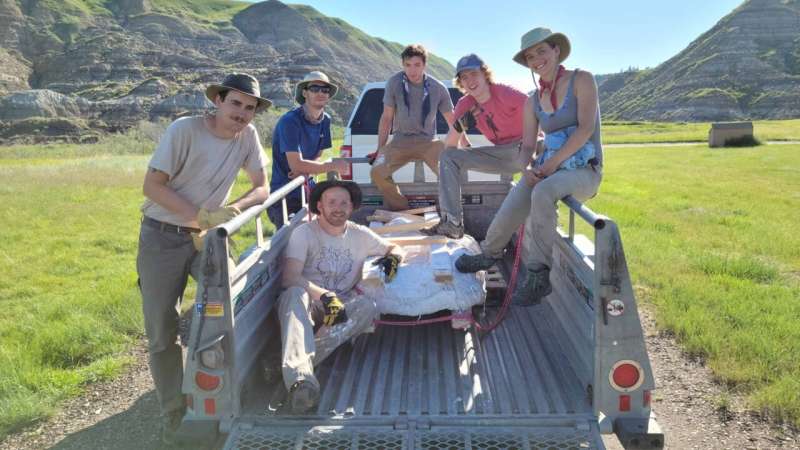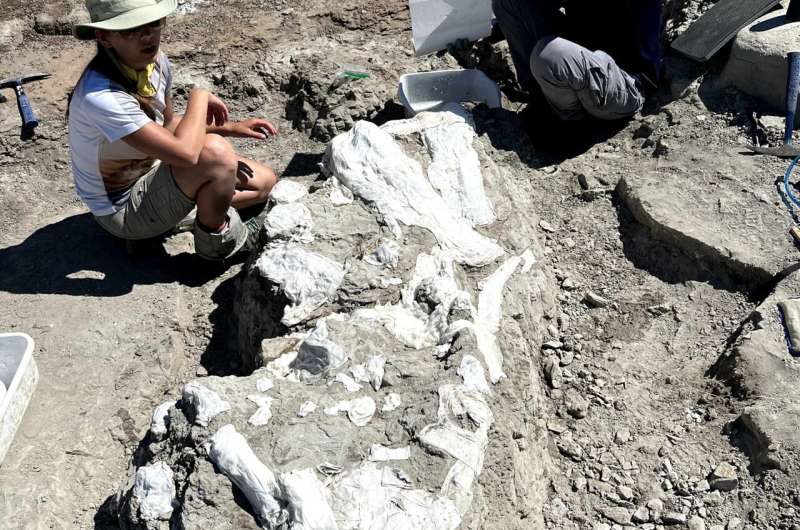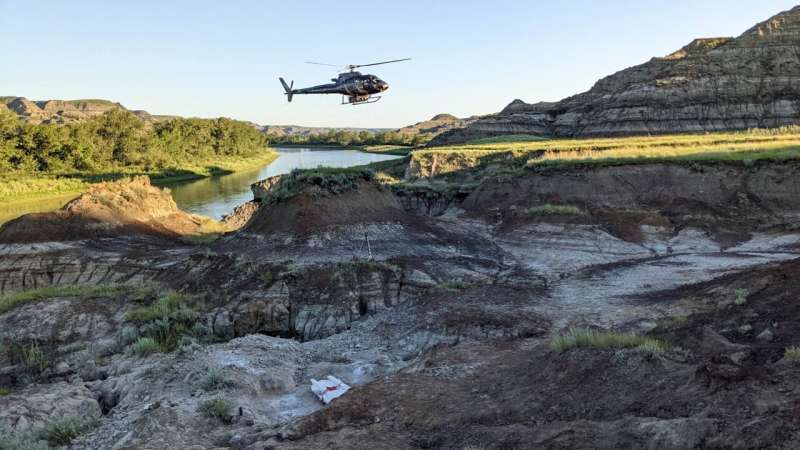Team members Colton Coppock, Nathaniel Morley, Mark Powers, Jordan Stock, Henry Sharpe and Christiana Garros with the excavated skeleton of "Gary." Credit: Yubo Ma
The process of unearthing a dinosaur skeleton from the ground, bit by bit, is complicated yet incredibly rewarding. The ups and downs of the excavation process is something Annie McIntosh and Mark Powers know all about—the two University of Alberta Ph.D. students led an expedition in a remote quarry in the Red Deer River valley that culminated with a hadrosaur skeleton being airlifted out by helicopter this summer.
"It's not that typical for students to lead field expeditions all that often, so that's pretty rare in and of itself," says Powers.
The duo were responsible for everything from writing research proposals to applying for permits and sourcing funding—all steps that need to be taken before serious excavation work can start. During field seasons, they ran the project, ensuring the worksite and the team's camp were running smoothly.
The process took several years to finish because the team was only able to be out in the field for a few weeks per year. "Because we are student-led, our funding is less than professors or people with a professional position, so that's a big reason we were limited to about two weeks a year [of fieldwork]," explains Powers.
Uncovering Gary the Edmontosaurus
Former team leader Gregory Funston initially discovered the specimen, and the first bones of the Edmontosaurus, eventually nicknamed Gary, were collected toward the end of the fieldwork season in 2018.
"It was in that first year that we realized we probably had at least an associated skeleton, if not an articulated skeleton, so that's what caused us to do further excavation in 2019," says Powers. An associated skeleton is when all the bones are present but scattered at an excavation site, whereas an articulated skeleton has the bones laid out as they were in the living dinosaur.
As McIntosh clarifies, excavation isn't done by tunneling into a hill, which could cause damage to whatever bones or fossils are inside. Instead, they take the methodical approach of slowly leveling the hill layer by layer to expose the bones buried beneath.
"We knew going back in 2019 that it [Gary] was going to be a focus of our fieldwork that year," says McIntosh. "That's when we opened the quarry and did all the heavy lifting and manual labor of getting all that rock out of the way."
Team members Christiana Garros and Giles Sukkert protect the exposed bones with paper towel before the plaster and burlap field jacket can be applied. Credit: Annie McIntosh
"We found it was very articulated and in a very interesting position. It made the excavation more complicated but it was a very impressive and unique find," adds Powers.
As he explains, most dinosaurs are typically found lying on their side in a relatively flat position, something the compression of layers of sediment and rock above them contributes to. Gary, however, was in what's called a "life position" when preserved, crouched rather than lying down.
'A blessing and a curse'
In 2021, the team ran into a problem they couldn't solve alone. Gary was an exciting find due to its size and rare position. But once the excavation reached a stage where they could see the entire skeleton, they realized their original extraction plan was no longer feasible.
Initially, the team had planned to break the elements of the skeleton into smaller groups that could be carried out manually, explains McIntosh. The intricacies of how Gary was positioned, though, made that impossible.
"Everything was too jumbled and right on top of each other," says McIntosh. "It's a blessing and a curse. It's really nice that the specimen is so complete and so well articulated, but it made that process a little more difficult.
"We realized the only way to break through it and make it into smaller pieces would be too much of a sacrifice of the skeleton, so we needed to think of something better."
With all the necessary protective jackets on the specimen, it weighed over 900 pounds. They had to figure out how to transport it from the remote location in the Red Deer River valley with virtually no budget for what would be a prohibitively expensive extraction.
A helicopter hovers above the fossilized skeleton of an Edmontosaurus, preparing to airlift the specimen from the quarry where it was unearthed by a student-led team. Credit: Christiana Garros
Sky-high success
They turned to the nearby community to see whether anyone would be able to help, and were stunned by the response. More than 60 people responded, some simply offering additional helping hands, others offering funds to aid in the students' mission.
The ideal solution came when L R Helicopters offered to airlift the specimen out for free. Shortly after that, the team stood by as Gary soared through the air.
"The process was amazing, honestly," says Powers. "This was my first time seeing something be hauled away into the sky, watching it until we can't see it anymore, hoping nothing falls."
"I was on the verge of tears, I was so excited," says McIntosh. "All that work we'd put into it over so many years was finally paying off. It was such a great experience."
Now that the specimen has been safely transported to the lab, the team is hard at work on the next stage in the process, preparing parts of the specimen and beginning projects to further analyze the various components, starting with the skull.
The team also plans to compare it with other specimens of the same species. That's because, while Gary may have been too large to be carried out by team members, it's notably smaller than other Edmontosaurus specimens scientists have unearthed.
"Gary would be the smallest individual of the species that it belongs to, so it's filling a pretty exciting gap that we have in our knowledge of that species," says McIntosh.
"Edmontosaurus was a very big animal, and they were around for millions of years leading to the end of the Cretaceous period," adds Powers. "It's remarkable that we've found so many, but never one like Gary."
Provided by University of Alberta


























